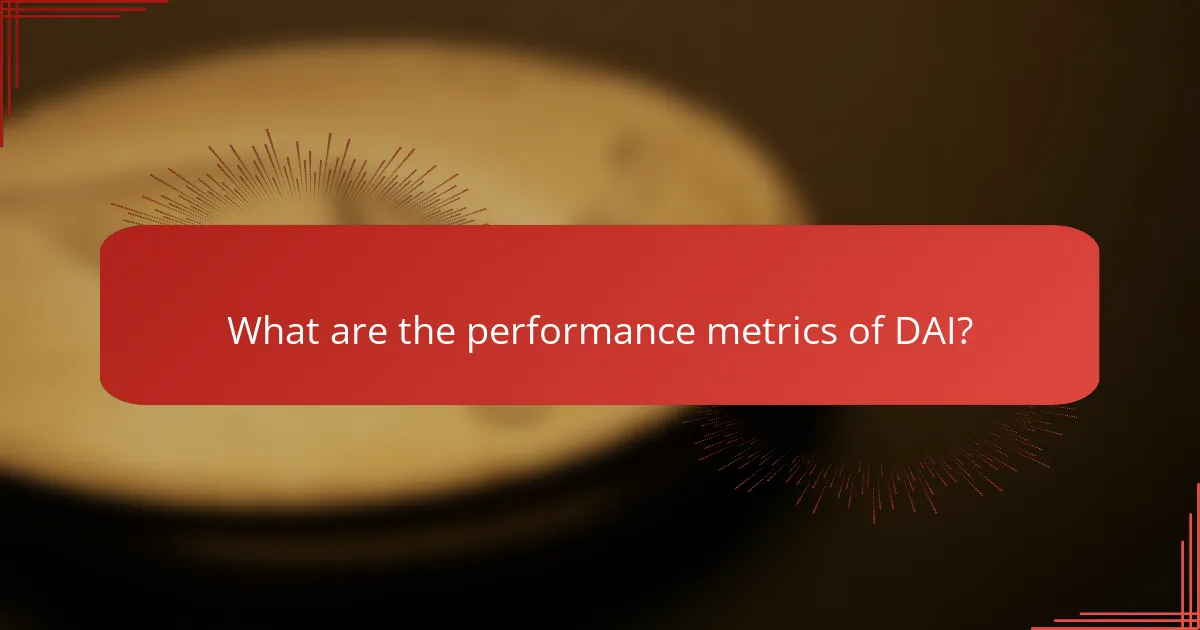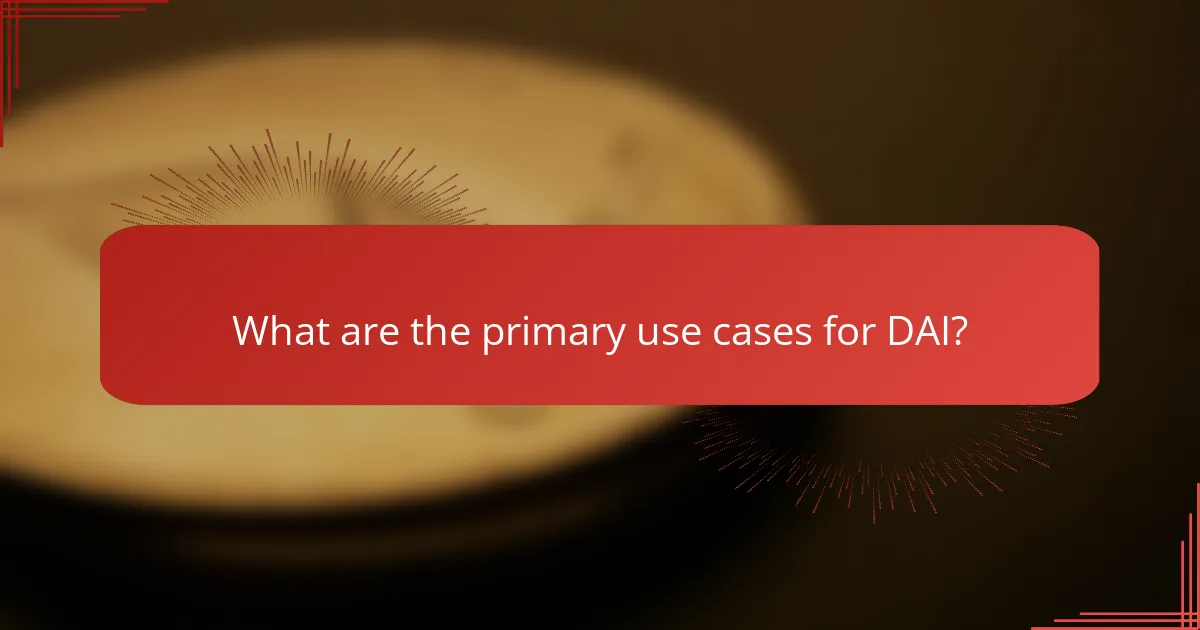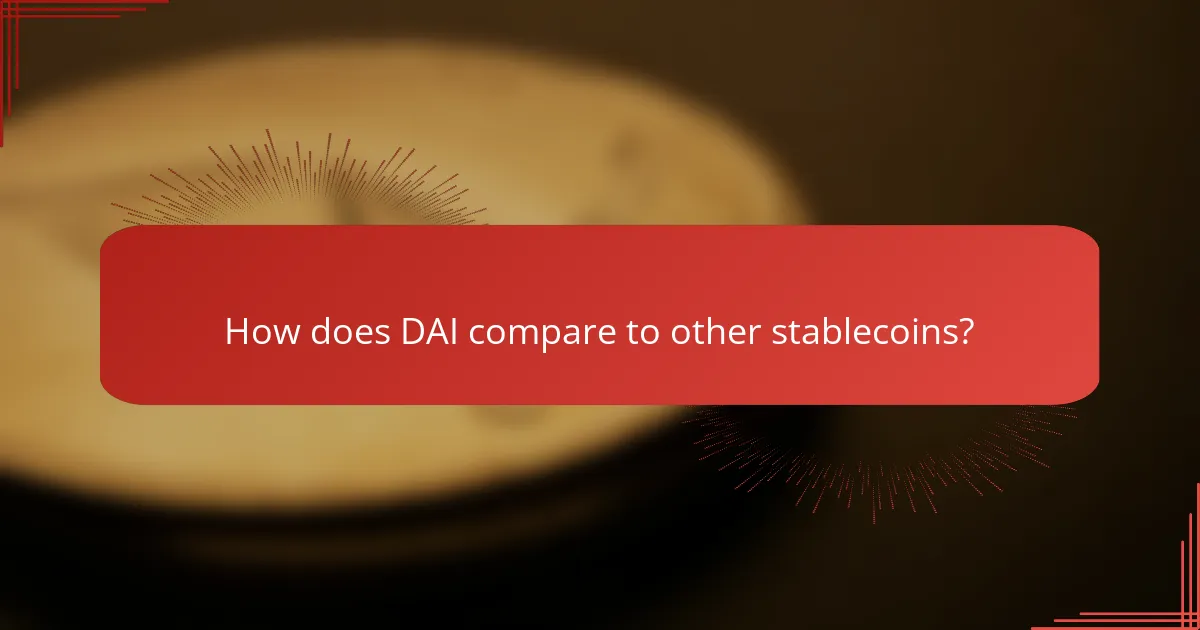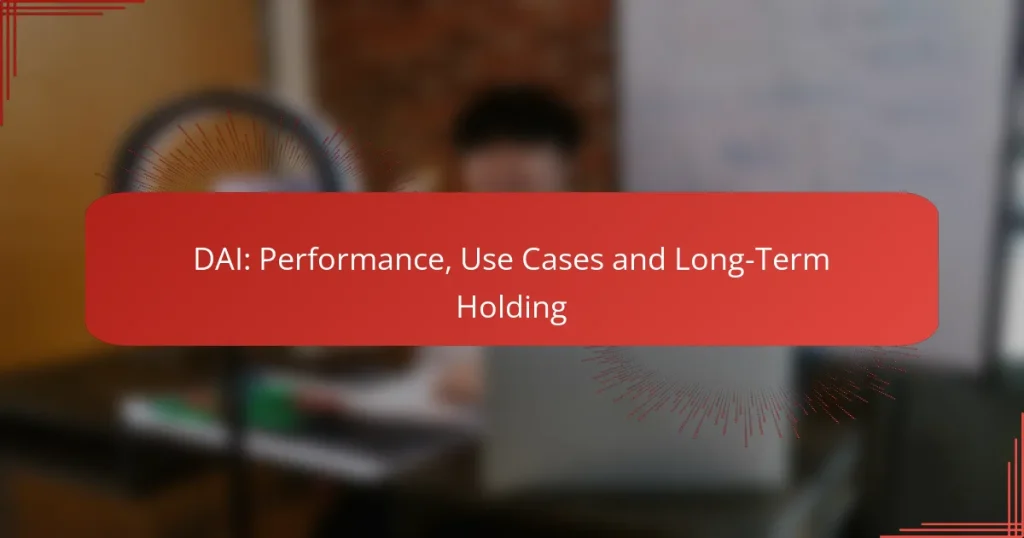DAI is a decentralized stablecoin pegged to the US dollar, known for its performance metrics such as market capitalization, price stability, and liquidity. It serves various use cases in decentralized finance (DeFi), trading, and cross-border payments, making it a versatile asset in the cryptocurrency landscape. For those considering long-term holding, adopting a secure wallet and a well-defined strategy is crucial to maintaining stability and managing risks effectively.

What are the performance metrics of DAI?
The performance metrics of DAI, a stablecoin pegged to the US dollar, include market capitalization, price stability, liquidity, transaction speed, and volatility trends. Understanding these metrics is essential for evaluating DAI’s effectiveness as a digital asset for trading and long-term holding.
Market capitalization
DAI’s market capitalization reflects its total value in circulation, which can fluctuate based on demand and supply dynamics. As of late 2023, DAI’s market cap typically ranges in the low billions of USD, positioning it among the top stablecoins in the market.
Investors should monitor market cap trends, as a significant increase may indicate growing adoption, while a decrease could suggest waning interest. This metric is crucial for assessing DAI’s overall stability and market presence.
Price stability
DAI aims to maintain a 1:1 peg to the US dollar, which is achieved through a system of collateralization and smart contracts. Price stability is critical for users relying on DAI for transactions and savings, as it minimizes the risk of value fluctuations.
While DAI generally exhibits strong price stability, occasional deviations may occur during market volatility. Users should be aware of these potential fluctuations and consider using DAI in conjunction with other stable assets for risk management.
Liquidity analysis
Liquidity refers to how easily DAI can be bought or sold without significantly impacting its price. DAI typically enjoys high liquidity across various exchanges, making it accessible for trading and transactions.
To ensure optimal liquidity, users should choose exchanges with high trading volumes and low spreads. This approach minimizes costs and enhances the efficiency of transactions involving DAI.
Transaction speed
DAI transactions are processed on the Ethereum blockchain, which generally offers transaction speeds in the range of seconds to a few minutes, depending on network congestion. Fast transaction speeds are advantageous for users needing timely transfers.
To optimize transaction speed, users can adjust gas fees during peak times, ensuring their transactions are prioritized. Understanding network conditions can help in planning transactions more effectively.
Volatility trends
While DAI is designed to be stable, it can still experience periods of volatility, particularly during significant market events. Monitoring volatility trends is essential for users who may be using DAI for trading or as a store of value.
Investors should analyze historical volatility patterns and consider diversifying their portfolios to mitigate risks associated with sudden price changes. Keeping abreast of market news can also provide insights into potential volatility spikes.

What are the primary use cases for DAI?
DAI is primarily used for decentralized finance (DeFi) applications, trading, cross-border payments, and executing smart contracts. Its stability as a decentralized stablecoin makes it a versatile tool in the cryptocurrency ecosystem.
Decentralized finance (DeFi) applications
DAI plays a crucial role in DeFi by enabling users to lend, borrow, and earn interest without intermediaries. Platforms like Aave and Compound allow users to deposit DAI and earn yields, while others enable borrowing against DAI collateral. This creates a dynamic environment where users can maximize their crypto assets’ utility.
When participating in DeFi with DAI, consider the risks associated with smart contract vulnerabilities and market volatility. Always assess the platform’s security measures and interest rates before engaging.
Stablecoin for trading
As a stablecoin, DAI is widely used for trading purposes, providing a reliable medium of exchange in the volatile crypto market. Traders often convert their assets into DAI to hedge against price fluctuations or to maintain liquidity during market downturns.
Using DAI for trading can simplify transactions across various exchanges. However, be aware of potential fees and slippage when converting between DAI and other cryptocurrencies.
Cross-border payments
DAI facilitates cross-border payments by allowing users to send funds quickly and with lower fees compared to traditional banking systems. Its decentralized nature means that transactions can occur without the need for intermediaries, making it an attractive option for international transfers.
When using DAI for cross-border payments, ensure that both the sender and receiver are familiar with the necessary wallets and transaction processes. Also, consider the regulatory environment in the recipient’s country, as it may affect the transaction.
Smart contracts execution
DAI is often utilized in smart contracts, enabling automated transactions based on predefined conditions. This capability enhances efficiency and reduces the need for manual intervention in various applications, from insurance to real estate.
When implementing smart contracts with DAI, ensure that the contract code is thoroughly audited to prevent exploits. Understanding the underlying blockchain’s capabilities and limitations is crucial for successful execution.

How to effectively hold DAI long-term?
To effectively hold DAI long-term, choose a secure wallet, implement a clear strategy, and manage risks wisely. This approach ensures that your investment remains stable and accessible while minimizing potential losses.
Best wallets for DAI
The best wallets for holding DAI include hardware wallets, software wallets, and decentralized wallets. Hardware wallets like Ledger and Trezor offer top-notch security by storing your private keys offline. Software wallets, such as Exodus and MetaMask, provide convenience and user-friendly interfaces for managing your DAI.
For those who prefer decentralized options, wallets like Argent and Gnosis Safe allow you to maintain control over your funds while interacting with DeFi platforms. Always ensure that the wallet you choose supports DAI and has a good reputation in the crypto community.
Strategies for long-term holding
When holding DAI long-term, consider dollar-cost averaging as a strategy. This involves regularly purchasing a fixed amount of DAI, which can reduce the impact of market volatility. Additionally, setting specific financial goals can help you determine when to sell or reinvest your holdings.
Another effective strategy is to stake your DAI in yield-generating platforms. This can provide passive income through interest or rewards, enhancing your overall returns while you hold the asset. However, always research the platforms thoroughly to ensure their reliability and security.
Risk management techniques
To manage risks associated with holding DAI, diversify your crypto portfolio. Avoid putting all your funds into a single asset, as this can expose you to significant losses. Instead, consider allocating your investment across different cryptocurrencies and stablecoins.
Additionally, regularly review your investment strategy and market conditions. Set stop-loss orders to limit potential losses and stay informed about regulatory changes that may impact DAI’s value. By staying proactive, you can better protect your long-term investment.

What are the prerequisites for investing in DAI?
Investing in DAI requires a basic understanding of blockchain technology and familiarity with decentralized finance (DeFi) platforms. These prerequisites ensure that investors can navigate the ecosystem effectively and make informed decisions.
Understanding blockchain technology
Blockchain technology is the backbone of DAI, a stablecoin that operates on the Ethereum network. Investors should grasp how blockchain works, including concepts like decentralization, smart contracts, and transaction validation. This knowledge helps in understanding how DAI maintains its peg to the US dollar.
Additionally, being aware of the security features and potential vulnerabilities of blockchain can aid in risk assessment. For instance, knowing about public and private keys is crucial for managing your DAI holdings safely.
Familiarity with DeFi platforms
To invest in DAI, you need to be comfortable using DeFi platforms where DAI can be traded or utilized. Popular platforms include MakerDAO, Uniswap, and Aave. Each platform has unique features, fees, and user interfaces, so it’s beneficial to explore a few options to find one that suits your needs.
Understanding how to swap DAI for other cryptocurrencies or use it as collateral for loans is vital. Start with small transactions to familiarize yourself with the processes and avoid significant losses. Always check for platform fees and security measures before committing your funds.

How does DAI compare to other stablecoins?
DAI is a decentralized stablecoin that aims to maintain a 1:1 peg to the US dollar, similar to other stablecoins but with unique mechanisms. Unlike centralized alternatives, DAI is governed by smart contracts on the Ethereum blockchain, which influences its stability and use cases.
Comparison with USDC
USDC is a centralized stablecoin issued by regulated financial institutions, while DAI operates in a decentralized manner. USDC is fully backed by US dollar reserves, making it easier to audit and trust for users who prioritize transparency and regulatory compliance.
In terms of stability, USDC typically maintains its peg more consistently due to its backing by fiat reserves. DAI, on the other hand, relies on over-collateralization of assets like Ethereum, which can lead to price fluctuations during market volatility. This difference can impact users’ choice depending on their risk tolerance and use case.
For users looking to engage in decentralized finance (DeFi), DAI offers advantages such as earning interest through lending platforms or participating in governance. Conversely, USDC is often favored for transactions requiring regulatory assurance and quick liquidity in centralized exchanges. Consider your priorities when choosing between these stablecoins.


